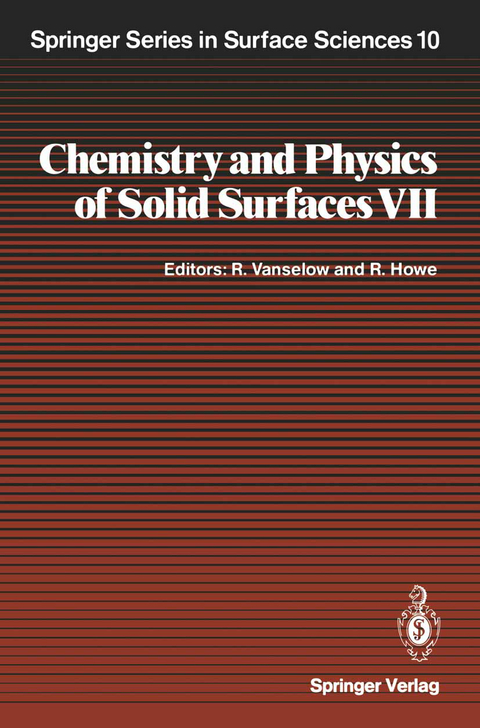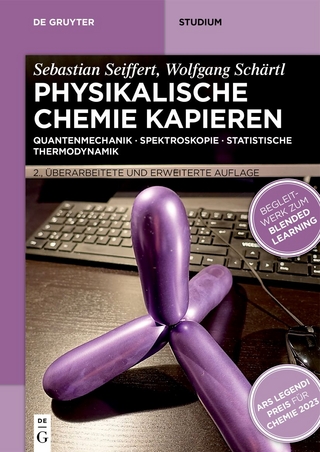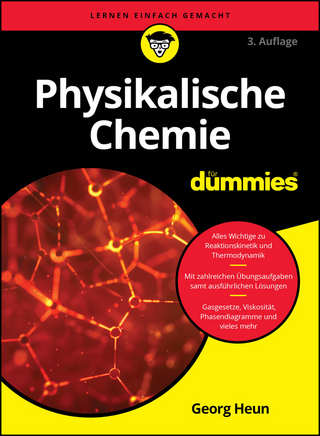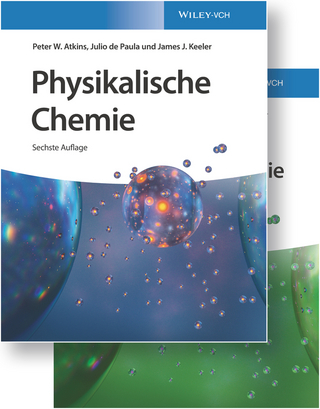
Chemistry and Physics of Solid Surfaces VII
Springer Berlin (Verlag)
978-3-642-73904-0 (ISBN)
1. Activated Chemisorption.- 1.1 A Brief History.- 1.2 Classification of Activated Chemisorption.- 1.2.1 Molecular Structure.- 1.2.2 Electronic Structure of the Gas.- 1.2.3 Electronic Structure of the Solid.- 1.2.4 Atomic Arrangement of the Solid.- 1.2.5 Strength of Chemisorption Bonding.- 1.2.6 Surprises.- 1.3 Formal Kinetics.- 1.3.1 Concentration Dependence of Chemisorption Rates.- 1.3.2 Temperature Dependencies.- 1.3.3 Angular and Mass Dependence.- 1.4 Case Studies in Activated Adsorption.- 1.4.1 Methane and Other Alkanes on Metal Surfaces.- 1.4.2 Hydrogen on Copper.- 1.4.3 Hydrogen on Elemental Semiconductors.- 1.4.4 Activated Adsorption on Densely Packed Planes.- a) Hydrogen and Nitrogen on W{110}, Re{0001}, and Ru{0001}.- b) Hydrogen on Platinum {111}.- c) Hydrogen on Nickel {111} and {110}.- 1.4.5 Slow Chemisorption of Nitrogen.- a) Nitrogen on Platinum Group Metals.- b) Chemisorption of Nitrogen on Iron.- 1.4.6 A Surprise: Oxygen on W{110}.- 1.5 Summary.- References.- 2. Physisorbed Rare Gas Adlayers.- 2.1 Experimental Techniques.- 2.1.1 General Remarks.- 2.1.2 Probe Particles.- a) Electrons.- b) Neutrons.- c) X-Ray Photons.- d) Helium Atoms.- 2.2 Solid-Solid Transitions in Two Dimensions.- 2.2.1 Commensurability.- 2.2.2 Fundamentals of the Theory Describing the Commensurate-Incommensurate Transition in 2D.- 2.2.3 The C-I Transition of Monolayer Xe on Pt{111}.- 2.2.4 Can High Order Commensurate Adlayers be Distinguished from Incommensurate Ones?.- i) Thermal expansion.- ii) Commensurate buckling.- iii) Lattice dynamical criterion.- iv) Bragg peak singularities.- 2.2.5 The I-HOC Phase Transition of Monolayer Kr on Pt{111}.- 2.2.6 Rotational Epitaxy of Monolayers.- 2.3 Multilayer Growth of Rare Gases.- 2.3.1 Dynamical Coupling Between Adlayer and Substrate.- 2.3.2Layer-by-Layer Evolution of the Lattice Dynamics.- 2.3.3 Growth Mode and the Scale of Substrate Strength.- 2.3.4 Epitaxial Layer Growth of Xe on Pt{111}.- 2.4 Conclusion.- References.- 3. Infrared Spectroscopy of Semiconductor Surfaces.- 3.1 Theoretical Framework.- 3.1.1 Macroscopic Theory (Three-Layer Model).- 3.1.2 Microscopic Model of the Active Layer.- 3.1.3 Model for Electronic Absorption.- 3.1.4 Discussion of the Assumption of Sharp Boundaries.- 3.1.5 First-Principle Calculations.- 3.2. Experimental Geometries and Techniques.- 3.2.1 Vibrational Modes in Substrate Optical Gap.- 3.2.2 Vibrational Modes in Substrate Absorption Region.- 3.2.3 Experimental Apparatus.- a) Surface Infrared Spectrometer.- b) Sample Geometry.- c) Other Techniques.- 3.3 Selected Examples.- 3.3.1 Structure of the Si{100}-(2x1)H System.- 3.3.2 H-saturated Si{100} and Ge{100} Surfaces.- 3.3.3 Dynamics of H on Si{100}.- 3.3.4 H2O on Si{100}.- 3.3.5 Electronic Absorption of Si{100} and Si{111}.- a) Si{100}.- b) Si{111}.- 3.3.6 Chemistry at Semiconductor Surfaces.- 3.4 Problems and Future Directions.- 3.5 Conclusions.- References.- 4. Surface Phonons - Theory.- 4.1 Discoveries and Advances.- 4.1.1 Advances in Experimental Studies of Surface Phonons.- 4.1.2 New Computational Methods.- A) Clean Surfaces.- a) Spectral Densities.- b) Surface Phonons and Resonances.- c) Anharmonic Effects.- d) First Principles Calculations of Surface Phonon Dispersion Curves.- B) Adsorbate Covered Surfaces.- a) A Single Adparticle.- b) A Periodic Array of Adatoms.- 4.2 Surface Phonons on Complex Crystals and Structures.- 4.2.1 Surface Phonon Anomalies Caused by the Electron-Phonon Interaction.- 4.2.2 Surface Phonon Kohn Anomalies.- 4.2.3 Molecular Crystals.- 4.2.4 Crystal Surfaces with High Miller Indices.- 4.2.5Reconstructed Surfaces.- 4.2.6 Amorphous Media.- 4.2.7 An Incommensurate Array of Adatoms.- 4.3 Some Directions for Future Research.- References.- 5. Interpretation of the NEXAFS Spectra of Adsorbates Using Multiple Scattering Calculations.- 5.1 Multiple Scattering Calculations of Near Edge Spectra of Molecules.- 5.2 Atomic and Diatomic Adsorbates.- 5.3 Computational Method for Complex Molecules and Clusters.- 5.4 More Complex Adsorbates.- 5.4.1 Ethylene and Ethylidyne on Pt{111}.- 5.4.2 Benzene on Pt{111}.- 5.4.3 Saturated Cyclic Hydrocarbons.- 5.4.4 Thiophene and Platinum Metallacycle.- 5.5 Conclusions.- References.- 6. Near-Edge X-Ray Absorption Fine Structure Spectroscopy: A Probe of Local Bonding for Organic Gases, Solids, Adsorbates, and Polymers.- 6.1 Development of NEXAFS: An Overview.- 6.2 Experimental Details.- 6.3 Results and Analysis.- 6.3.1 The Signatures of Individual Bonds.- 6.3.2 Assembly of Diatomics to Functional Groups.- 6.3.3 The Fingerprints of Functional Groups.- 6.3.4 Assembly of Functional Groups to Macromolecules.- 6.3.5 Limitations of the Building Block Approach.- 6.4 Conclusions and Future Prospects.- References.- 7. Surface Kinetics with Near Edge X-Ray Absorption Fine Structure.- 7.1 An Overview of Methods for Characterizing Surface Reactions.- 7.2 Transient Near-Edge X-ray Absorption Fine Structure (NEXAFS) as a Probe of Surface Reactions.- 7.2.1 Soft X-ray Absorption Using Electron Detection.- 7.2.2 CO Desorption from the Pt{111} Surface.- 7.2.3 Pyridine Reorientation of the Ag{111} Surface.- 7.2.4 Ethylene Conversion to Ethylidyne on the Pt{111} Surface.- 7.2.5 Summary: Transient NEXAFS Using Electron Detection.- 7.3 Fluorescence Yield Near-Edge Structure (FYNES).- in the Soft X-ray Region.- 7.3.1 Apparatus.- 7.3.2 Summary: Soft X-ray Absorption Using Fluorescence Detection.- 7.4 Future Opportunities.- References.- 8. Overview of Electron Microscopy Studies of the So-Called "Strong Metal-Support Interaction" (SMSI).- 8.1 Experimental.- 8.2 Results and Discussion.- 8.3 Summary.- References.- 9. Theory of Desorption Kinetics.- 9.1 Nonequilibrium Thermodynamics of a Two-Phase Adsorbate.- 9.1.1 Preliminary Comments.- 9.1.2 General Formulation.- a) Adsorption.- b) Desorption.- c) Two-Dimensional Condensation and Evaporation.- d) Equilibration of the 2D Gas Phases.- e) Equilibrium Properties.- 9.1.3 Results.- 9.1.4 A Simplified Model.- 9.2 Microscopic Approaches.- 9.3. Outlook.- References.- 10. Fractals in Surface Science: Scattering and Thermodynamics of Adsorbed Films.- 10.1 Fundamentals of Fractal Geometry.- 10.1.1 Definition 1.- 10.1.2 Definition 2.- 10.2 Small-Angle Scattering from Fractal Surfaces.- 10.2.1 Theorem 1.- 10.2.2 Theorem 2.- 10.2.3 Theorem 3.- 10.3 Application: Small-Angle He Scattering from Adsorbate Islands on an Ordered Surface.- 10.4 Scattering from a Diffusing Adsorbate on a Fractal Surface.- 10.5 Henry's Law of Adsorption on a Fractal Surface.- 10.6 BET Condensation of a Gas on a Fractal Surface.- 10.7 Bose-Einstein Condensation in Nonintegral Dimensions.- 10.8 Conclusion.- References.- 11. Critical Phenomena of Chemisorbed Atoms and Reconstruction - Revisited.- 11.1 Brief Recap.- 11.2 Results from Computed Structure Factors.- 11.2.1 General Features.- 11.2.2 Diffraction-Limit Results.- 11.2.3 Energy-Like Limit.- 11.2.4 Melting to an Incommensurate Disordered Phase.- 11.2.5 Critical Behavior at Temperature-Driven First-Order Transitions.- 11.2.6 Effects of Defects.- 11.3 Experimental Progress Since ISISS-1981.- 11.3.1 4-State Potts Systems: O/Ru{0001}.- 11.3.2 Ising Systems.-11.3.3 XY with Cubic Anisotropy.- 11.3.4 Se/Ni{100}: Realization of the Ashkin-Teller Model?.- 11.4 Conclusions.- References.- 12. Surface Electronic Interactions of Slow Ions and Metastable Atoms.- 12.1 Electron Ejection by Auger Neutralization (AN) and Auger De-excitation (AD).- 12.2 Resonance Tunneling Makes Two-Stage Processes Possible.- 12.3 Matrix Elements, Transition Rates, and Related Probability Functions.- 12.4 Variation of Atomic Energy Levels Near a Solid Surface.- 12.5 Excitation Conversion of He*(1S) to He*(3S).- 12.6 What Determines the Ultimate Mode of Electron Ejection?.- 12.7 A Selective Listing of Investigations with Some Comments.- 12.8 Summary.- References.- 13. Equilibrium Crystal Shapes and Interfacial Phase Transitions.- 13.1 Introduction.- 13.2 The Crystal Shape as a Free Energy.- 13.3 The Wulff Construction as Legendre Transformation.- 13.4 Applications.- 13.4.1 Facets, Cusps, and Roughening.- 13.4.2 Sharp Edges, Thermal Faceting, and Forbidden Regions of the Wulff Plot.- 13.4.3 T=0 Roughening and the Degeneracy of Corners and Edges.- 13.4.4 The Statistical Mechanics of Crystal Shapes.- 13.4.5 Critical Behavior of the Equilibrium Crystal Shape.- 13.4.6 Calculating the Shapes of Real Crystals.- 13.5 Open Questions.- References.- 14. Experimental Aspects of Surface Roughening.- 14.1 Equilibrium Crystal Shapes and Surface Roughening.- 14.2 The Detection of Steps on Surfaces.- 14.3 Energetics of Step Formation and Surface Diffusion.- 14.4 Diffraction Studies of the Roughening Transition.- 14.5 The Dependence of TR on Crystal Orientation.- 14.6 Conclusions.- References.- 15. Relationship Between Anisotropy of Specific Surface Free Energy and Surface Reconstruction.- 15.1 Introduction.- 15.2 Anisotropics of Specific Surface Free Energy, ?(?).-15.2.1 Experiment.- 15.2.2 Theory.- 15.3 Reconstruction of Pt{110} - Surface Self-Diffusion Measurements.- 15.4 Surface-Atom Core Level Shifts of Pt.- 15.5 Adsorbate-Induced Reconstruction.- 15.6 Reconstruction and Faceting - a Comparison.- References.- 16. Surface Melting.- 16.1 Melting and the Role of the Surface.- 16.2 Thermodynamics of Surface Melting.- 16.2.1 Driving Force.- 16.2.2 Which Surfaces Do Melt?.- 16.2.3 Crystal-Face Dependence of Surface Melting.- 16.2.4 Molecular Dynamics Simulations and Phenomenological Theories.- 16.3 Observations of Surface Melting.- 16.3.1 Calorimetry.- 16.3.2 Optical Measurements.- 16.3.3 Rutherford Backscattering of Ions.- a) Shadowing and Blocking.- b) Backscattering from a Melted Surface.- c) Melting of Pb{110}.- d) Melting or Non-Melting of Pb{hkl}.- 16.3.4 Diffraction.- 16.3.5 Neutron and He Scattering.- 16.4 Summary and Outlook.- References.- 17. The Surface of Solid Helium.- 17.1 Review of the Properties of Helium-4.- 17.2 Growth of Solid Helium-4.- 17.2.1 Melting-Freezing Waves.- 17.2.2 Boundary Conditions at a Moving Interface.- 17.2.3 Kapitza Resistance.- 17.2.4 Growth Coefficient.- 17.2.5 High Velocity Growth.- 17.3 Facets and Facetting Transitions.- 17.3.1 Roughening Temperatures.- 17.3.2 Theoretical Situation.- 17.3.3 Experimental Results Near Roughening Transitions.- 17.4 Helium-3.- 17.5 Summary.- References.- 18. Solving Complex and Disordered Surface Structures with Electron Diffraction.- 18.1 Introduction.- 18.1.1 The Past.- 18.1.2 The Objective.- 18.2 Towards Diffraction from Complex and Disordered Surfaces.- 18.2.1 The Problem.- 18.2.2 Basic LEED Methods.- 18.2.3 Theoretical Solutions.- a) Cluster Methods.- b) Reducing Multiple-Scattering Paths.- c) Kinematic Sublayer Addition.- d) Forward Focusing.- e) BeamSet Neglect.- f) Tensor LEED.- g) Combinations.- 18.3 Order vs Disorder and Diffraction.- 18.4 Cluster-Oriented Approaches.- 18.4.1 Kinematic Cluster Addition.- 18.4.2 Near-Field Expansion in Clusters.- 18.5 Beam-Oriented Approaches.- 18.5.1 Plane Waves Despite Large Unit Cells and Disorder.- 18.5.2 Beam Set Neglect.- a) Two Important Beam Sets.- b) Accuracy of Beam Set Neglect.- c) Surface Reconstruction.- d) Disorder.- e) Incommensurate Overlayers.- f) Combination with Other Methods.- g) Advantages and Disadvantages of BSN.- 18.5.3 Kinematic Sublayer Addition.- 18.6 Experimental Requirements.- 18.7 Conclusions.- References.- 19. Recent Developments in Scanning Tunneling Microscopy and Related Techniques.- 19.1 Scanning Tunneling Microscopy.- 19.1.1 Study of Surface Atomic and Electronic Structure.- 19.1.2 Other Applications of STM.- 19.2 The Atomic Force Microscope.- 19.3 Related Microscopies.- References.- 20. Growth Kinetics of Silicon Molecular Beam Epitaxy.- 20.1 Two Dimensional Growth of the Matrix.- 20.1.1 Vertical Growth by Lateral Motion of Surface Steps.- 20.1.2 Burton-Cabrera-Frank (BCF) Theory.- 20.1.3 LEED/RHEED Oscillations.- 20.2 Impurity Incorporation into Si-MBE Layers.- 20.2.1 Secondary Implantation.- 20.3 Limits of the Two-Dimensional (2D) Growth Mode.- 20.3.1 Surface Contamination.- 20.3.2 Heteroepitaxy.- 20.3.3 The SiGe/Si System.- 20.4 Conclusion.- References.
| Erscheint lt. Verlag | 27.12.2011 |
|---|---|
| Reihe/Serie | Springer Series in Surface Sciences |
| Zusatzinfo | XVII, 616 p. |
| Verlagsort | Berlin |
| Sprache | englisch |
| Maße | 155 x 235 mm |
| Gewicht | 954 g |
| Themenwelt | Naturwissenschaften ► Chemie ► Physikalische Chemie |
| Naturwissenschaften ► Physik / Astronomie ► Atom- / Kern- / Molekularphysik | |
| Naturwissenschaften ► Physik / Astronomie ► Festkörperphysik | |
| Naturwissenschaften ► Physik / Astronomie ► Theoretische Physik | |
| Technik ► Maschinenbau | |
| Schlagworte | Chemistry • Epitaxy • EXAFS • Kinetics • metals • NEXAFS • semiconductor • spectroscopy • Surface • Surface Science |
| ISBN-10 | 3-642-73904-0 / 3642739040 |
| ISBN-13 | 978-3-642-73904-0 / 9783642739040 |
| Zustand | Neuware |
| Informationen gemäß Produktsicherheitsverordnung (GPSR) | |
| Haben Sie eine Frage zum Produkt? |
aus dem Bereich


